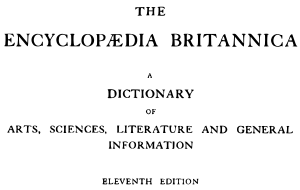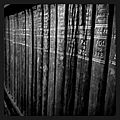1911 Encyclopædia Britannica facts for kids

First page of the Encyclopædia Britannica, Eleventh Edition
|
|
| Country | United States |
|---|---|
| Language | British English |
|
Release number
|
11 |
| Subject | General |
| Publisher | Horace Everett Hooper |
|
Publication date
|
1910-11 |
| Media type | Print and Digital |
| Preceded by | Encyclopædia Britannica Tenth Edition |
| Followed by | Encyclepædia Britannica Twelfth Edition |
| Text | Encyclopædia Britannica Eleventh Edition at Wikisource |
The Encyclopædia Britannica Eleventh Edition is a very famous version of the Encyclopædia Britannica. It was published between 1910 and 1911. Many articles in this edition were written by the smartest people of that time.
Even today, these articles are helpful for learning about the knowledge from the 1800s and early 1900s. However, some information might not be completely accurate for modern studies. This edition is no longer protected by copyright laws. This means anyone can read it for free online. You can find it in its original form or as part of other online encyclopedias.
Contents
Creating the Eleventh Edition
The 1911 Eleventh Edition was put together by an American publisher named Horace Everett Hooper. Hugh Chisholm was the editor who oversaw the project. New ways of selling books helped it become very popular.
About 11% of the people who wrote for the encyclopedia were American. A special office was set up in New York to manage their work.
Famous Writers and Topics
Many well-known experts of the time wrote articles for this edition. Some of these famous writers included Edmund Gosse, J. B. Bury, and G. K. Chesterton. Even John Muir, a famous naturalist, contributed.
The Eleventh Edition changed how the Britannica was published. It was the first time all volumes were released at once. Before, they came out one by one as they were finished.
The encyclopedia covered many different subjects. Here's a quick look at what was inside:
| Subject | Content |
|---|---|
| Geography | 29% |
| Pure and applied science | 17% |
| History | 17% |
| Literature | 11% |
| Fine art | 9% |
| Social science | 7% |
| Psychology | 1.7% |
| Philosophy | 0.8% |
Why It's Still Important
The 1911 Encyclopædia Britannica is often used as a source today. This is because it was very respected when it came out. Also, since it's now in the public domain, it's free for everyone to use.
Many modern projects have used it as a starting point. For example, parts of it have been used in Wikipedia. It also forms the basis for the Gutenberg Encyclopedia.
The Gutenberg Encyclopedia
The Project Gutenberg Encyclopedia is actually the Eleventh Edition of the Encyclopædia Britannica. It was given a new name to avoid problems with Britannica's trademark. This means you can read the entire 1911 edition for free online through Project Gutenberg.
Here are some parts of the Gutenberg Encyclopedia you can find online:
| Section | From | To | Links | |
|---|---|---|---|---|
| Volume 1: | A | – | Androphagi | [1] |
| Volume 2.1.1: | Andros, Sir Edmund | – | Anise | [2] |
| Volume 4.3: | Bréquigny | – | Bulgaria | [3] |
| Volume 4.4: | Bulgaria | – | Calgary | [4] |
Images for kids
See also
 In Spanish: Encyclopædia Britannica (edición de 1911) para niños
In Spanish: Encyclopædia Britannica (edición de 1911) para niños



